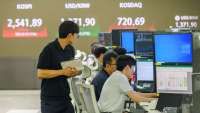VIRUS CORONA - WASHINGTON. The U.S. economy lost a staggering 20.5 million jobs in April, the steepest plunge in payrolls since the Great Depression and the starkest sign yet of how the novel coronavirus pandemic is battering the world’s biggest economy.
The Labor Department’s closely watched monthly employment report on Friday also showed the unemployment rate surging to 14.7% last month, shattering the post-World War Two record of 10.8% touched in November 1982. It strengthened analysts’ views of a slow recovery from the recession caused by lockdowns imposed by states and local governments in mid-March to curb the spread of COVID-19, the respiratory illness caused by the virus.
The economic crisis spells trouble for President Donald Trump’s bid for a second term in the White House in November’s election. After the Trump administration was criticized for its initial reaction to the pandemic, Trump is eager to reopen the economy, despite a continued rise in COVID-19 infections and dire projections of deaths.
“If there is a silver-lining in today’s dismal jobs report, it is in the realization that the economy cannot possibly get any worse than it is right now,” said Chris Rupkey, chief economist at MUFG in New York. “Joblessness can only diminish from this point forward as many states start reopening.”
Economists polled by Reuters had forecast nonfarm payrolls diving by 22 million. Data for March was revised to show 870,000 jobs lost instead of 701,000 as previously reported. A record streak of job growth dating to October 2010 ended in March.
The jaw-dropping job losses in the last two months pushed nonfarm employment to its lowest level since February 2011. Job losses were almost across the board, with leisure and hospitality industry payrolls plunging 7.7 million. Restaurants and bars accounted for nearly three-quarters of the decline.
Ironically, healthcare employment declined by 1.4 million jobs, with decreases at offices of dentists, doctors, other health practitioners and hospitals.
Dentists have closed offices, while general practitioners and hospitals have seen a reduction in patient visits as people stay at home in fear of contracting the highly contagious virus. Hospitals have also suspended elective surgeries to focus on the treatment of COVID-19 patients.
Stocks on Wall Street were trading higher on easing tensions between the United States and China. The dollar was little changed against a basket of currencies, while U.S. Treasury prices were trading lower.
Read Also: Chinese factories struggle to fire in April as slump in export orders deepens
MILLIONS UNEMPLOYED
Though the unemployment rate jumped from 4.4% in March, its ascent was blunted by the drop of 6.432 million from the labor force. Some of the people who lost their jobs but are unable to look for work because of the coronavirus are not counted as unemployed. According to the Labor Department’s Bureau of Labor Statistics, which compiles the employment report, a person has to be looking for work and available to do it to be considered unemployed.
The labor force participation rate, the proportion of working-age Americans who have a job or are looking for one, dropped 2.5 percentage points to 60.2% in April, the lowest rate since January 1973. A broader measure of unemployment, which includes people who want to work but have given up searching and those working part-time because they cannot find full-time employment, surged to 22.8% last month from 8.7% in March.
The employment-to-population ratio, which is viewed as a better measure of an economy’s ability to create employment, tumbled 8.7 percentage points to 51.3%, the lowest rate since the series started in 1948. Unemployment rose for all demographic groups last month.
With the mandated business shutdowns hitting workers hard in the lower-wage leisure and hospitality industry, average hourly earnings shot up 4.7% in April from 0.5% in the prior month. That boosted the annual increase in wages to 7.9% April. The workweek averaged 34.2 hours last month.
Though millions of Americans continue to file claims for unemployment benefits, April could mark the trough in job losses. More small businesses are accessing their portion of an almost $3 trillion fiscal package, which made provisions for them to get loans that could be partially forgiven if they were used for employee salaries.
The Federal Reserve has also thrown businesses credit lifelines and many states are also partially reopening.
Read Also: Next wave of U.S. states set to reopen as coronavirus could push jobless rate to 16%
Companies like Walmart and Amazon are hiring workers to meet huge demand in online shopping. Truck drivers are also in demand, while supermarkets, pharmacies and courier companies need workers. Still, economists do not expect a quick rebound in the labor market.
“Given the expected shift in consumer behavior reflecting insecurities regarding health, wealth, income, and employment, many of these firms will not reopen or, if they do reopen, hire fewer people,” said Steve Blitz, chief economist at TS Lombard in New York. “This is one reason why we see the underlying recession extending through the third quarter.”
Economists say the economy entered recession in late March, when nearly the whole country went into COVID-19 lockdowns.
The National Bureau of Economic Research, the private research institute regarded as the arbiter of U.S. recessions, does not define a recession as two consecutive quarters of decline in real gross domestic product, as is the rule of thumb in many countries. Instead, it looks for a drop in activity, spread across the economy and lasting more than a few months.
/2020/05/07/961931169p.jpg)









